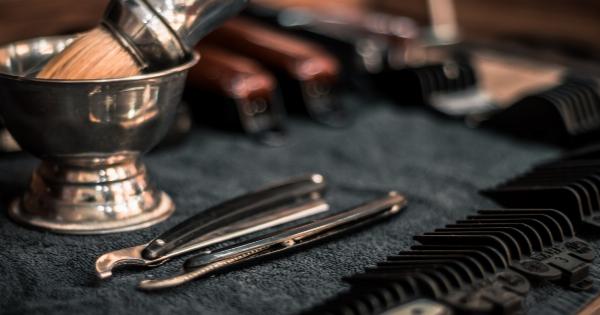Are you struggling with thinning hair or baldness? Don’t worry, you’re not alone! Hair loss is a common problem that affects millions of people around the world.
Whether it’s due to genetics, hormonal changes, stress, or medical conditions, losing your hair can be a blow to your self-esteem and confidence. But fret not, because in this article, we will discuss the guaranteed solution to hair loss that can help you regain your thick and luscious locks.
The Causes of Hair Loss
Before we delve into the solution, let’s take a quick look at the various factors that contribute to hair loss:.
1. Genetics: One of the primary reasons for hair loss is your genetic makeup. If hair loss runs in your family, chances are you might experience it too.
2. Hormonal Imbalance: Fluctuations in hormones can lead to temporary or permanent hair loss. This is why many women experience hair thinning or shedding during pregnancy or menopause.
3. Stress and Lifestyle: Chronic stress, poor diet, lack of sleep, smoking, and excessive alcohol consumption can all contribute to hair loss. Making positive lifestyle changes can help prevent hair loss.
4. Medical Conditions: Certain medical conditions like alopecia areata, thyroid disorders, and scalp infections can result in hair loss. Treating the underlying condition can help in preventing further hair loss.
Topical Solutions for Hair Loss
While there are numerous over-the-counter solutions and treatments available for hair loss, not all of them deliver the promised results.
However, there is one guaranteed solution that has shown remarkable success in combatting hair loss – topical treatments containing minoxidil.
What is Minoxidil?
Minoxidil is an FDA-approved topical medication that has been extensively studied and proven to promote hair growth in both men and women.
Originally developed as an oral drug to treat high blood pressure, researchers discovered that it had a pleasant side effect – it stimulated hair growth.
Nowadays, minoxidil is available in the form of a topical solution or foam and is widely used for treating hair loss.
It works by dilating the blood vessels in the scalp, improving blood circulation, and stimulating hair follicles to produce thicker, fuller hair.
How to Use Minoxidil?
Using minoxidil is a straightforward and hassle-free process:.
1. Consult a Dermatologist: Before starting any hair loss treatment, it’s crucial to consult a dermatologist to determine the underlying cause of your hair loss. They can prescribe the appropriate dosage of minoxidil for your specific needs.
2. Clean and Dry Scalp: Ensure your scalp is clean and dry before applying minoxidil. This allows the medication to penetrate the scalp more effectively.
3. Apply the Solution or Foam: Following the instructions provided, apply the minoxidil solution or foam directly onto the affected areas of your scalp. Gently massage it into your scalp with your fingertips.
4. Let It Dry: Allow the minoxidil to dry completely before styling your hair or going to bed. This usually takes around 2-4 hours.
5. Be Consistent: For effective results, it’s crucial to use minoxidil regularly as prescribed. Most people apply it twice a day.
Other Hair Loss Treatments
In addition to minoxidil, there are other hair loss treatments available that can complement its effectiveness:.
Diet and Nutrition
Eating a well-balanced diet rich in essential nutrients, vitamins, and minerals is essential for promoting healthy hair growth. Include foods like fruits, vegetables, whole grains, lean proteins, and healthy fats in your diet.
Scalp Massage
Gently massaging your scalp daily for a few minutes can help improve blood circulation to the hair follicles, promoting hair growth. You can use your fingertips or a soft-bristled brush for this purpose.
Avoid Harsh Styling and Treatments
Avoid subjecting your hair to excessive heat, chemical treatments, and harsh styling techniques. These can weaken the hair shaft and lead to breakage and hair loss. Opt for gentle styling methods and protect your hair from harmful UV rays.
Stress Management
Stress not only affects your overall well-being but can also contribute to hair loss. Incorporate stress-management techniques like exercise, meditation, or yoga into your daily routine to reduce stress levels.
When to Expect Results?
Results may vary from person to person when using minoxidil. Some may start noticing improvement within a few weeks, while others may take a few months. It’s essential to be patient and consistent with your treatment to see optimal results.
Possible Side Effects
While minoxidil is generally safe and well-tolerated, it can cause some side effects in a few individuals:.
1. Scalp Irritation: Some people may experience redness, itching, or dryness of the scalp. These symptoms usually subside within a few days.
2. Increased Hair Shedding: Initially, you may notice increased hair shedding. Don’t panic! This is a sign that minoxidil is working and stimulating new hair growth.
3. Facial Hair Growth: In some cases, minoxidil can cause unwanted hair growth on the face or other areas it comes in contact with. Avoid contact with such areas and wash your hands thoroughly after application.
The Final Takeaway
If you’re struggling with hair loss, minoxidil is a tried and tested solution that can help you regain your hair’s vitality and thickness.
When used correctly and consistently, alongside a healthy lifestyle and proper hair care routine, minoxidil can be your ultimate weapon against hair loss. Consult a dermatologist to determine if minoxidil is suitable for you and get started on your journey to regaining the confidence that comes with a full head of hair!.





























